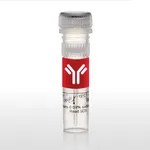Thermo Fisher Scientific HIF1A VHH-8His-Cys-tag Recombinant Alpaca Monoclonal Antibody (SAA1239)
| 상품 옵션 정보 | |||||||||
|---|---|---|---|---|---|---|---|---|---|
| 카탈로그 번호 | CAS 번호 | 설명 | 상태 | 재고 | 단위 | 판매가 | 할인가 | 가격(VAT포함) | 수량 / 장바구니 / 찜 |
| MA554597 | - | Thermo Fisher Scientific MA554597 HIF1A VHH-8His-Cys-tag Recombinant Alpaca Monoclonal Antibody (SAA1239) 100 ug pk | 재고문의 | pk | 0원 | - | 0원 | ||
다른 상품 둘러보기
Applications
Tested Dilution
Publications
Western Blot (WB)
Assay-dependent
ELISA (ELISA)
Assay-dependent
Product Specifications
Species Reactivity
Human
Host/Isotype
Alpaca / VHH
Expression System
CHO cells
Class
Recombinant Monoclonal
Type
Antibody
Clone
SAA1239
Immunogen
Recombinant Human HIF1A.
Conjugate
Unconjugated Unconjugated Unconjugated
Form
Liquid
Concentration
1 mg/mL
Purification
Metal-chelate chromatography
Storage buffer
PBS
Contains
no preservative
Storage conditions
Store at 4°C short term. For long term storage, store at -20°C, avoiding freeze/thaw cycles.
Product Specific Information
Compatible with Direct ELISA
Target Information
HIF1-alpha (HIF1A) is a subunit of HIF1, which is a transcription factor found in mammalian cells cultured under reduced oxygen tension. HIF-1 is a heterodimer consisting of an alpha and beta subunit, both belonging to the basic-helix-loop-helix Per-aryl hydrocarbon receptor nuclear translocator-Sim (PAS) family of transcription factors. HIF1 functions as a transcriptional regulator of the adaptive response to hypoxia. Under hypoxic conditions, HIF-1 activates the transcription of over 40 genes, including erythropoietin, glucose transporters, glycolytic enzymes, vascular endothelial growth factor, HILPDA, and other genes whose protein products increase oxygen delivery or facilitate metabolic adaptation to hypoxia. HIF1-alpha regulates hypoxia-mediated apoptosis, cell proliferation and tumor angiogenesis. Hypoxia which induces p53 protein accumulation, directly interacts with HIF1-alpha and reduces hypoxia-induced expression of HIF1-alpha by promoting MDM2-mediated ubiquitination and proteasomal degradation under hypoxic conditions. Recent studies suggest that induction of NOX4 by HIF1-alpha contributes to maintain ROS levels after hypoxia and hypoxia-induced proliferation. In humans, it is located on the q arm of chromosome 14. The C-terminal of HIF1A binds to p300. p300/CBP-HIF complexes participate in the induction of hypoxia-responsive genes, including VEGF. Hypoxia contributes significantly to the pathophysiology of major categories of human disease, including myocardial and cerebral ischemia, cancer, pulmonary hypertension, congenital heart disease and chronic obstructive pulmonary disease.
For Research Use Only. Not for use in diagnostic procedures. Not for resale without express authorization.
배송/결제/교환/반품 안내
배송 정보
| 기본 배송비 |
| 교환/반품 배송비 |
|
|---|---|---|---|
| 착불 배송비 |
| ||
| 교환/반품 배송비 |
| ||
결제 및 환불 안내
| 결제 방법 |
|
|---|---|
| 취소 |
|
| 반품 |
|
| 환급 |
|
교환 및 반품 접수
| 교환 및 반품 접수 기한 |
|
|---|---|
| 교환 및 반품 접수가 가능한 경우 |
|
| 교환 및 반품 접수가 불가능한 경우 |
|
교환 및 반품 신청
| 교환 절차 |
|
|---|---|
| 반품 절차 |
|

